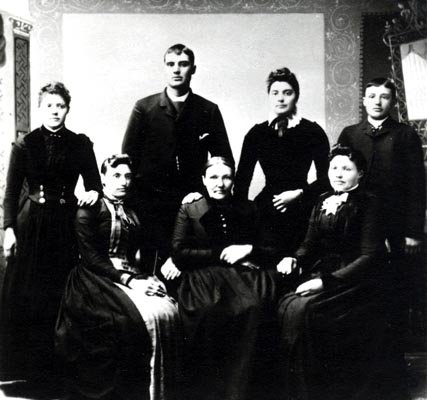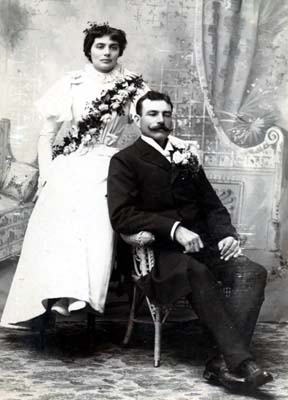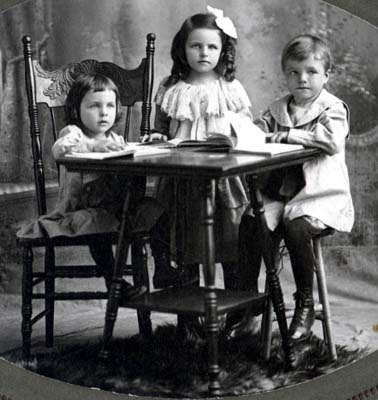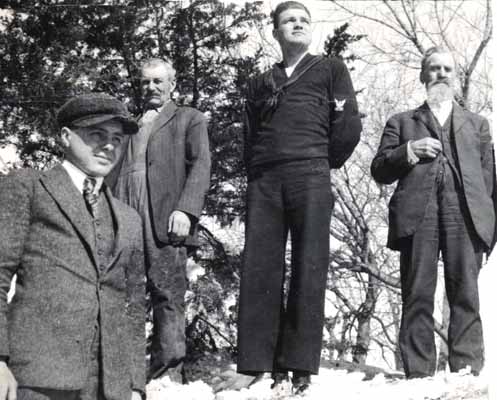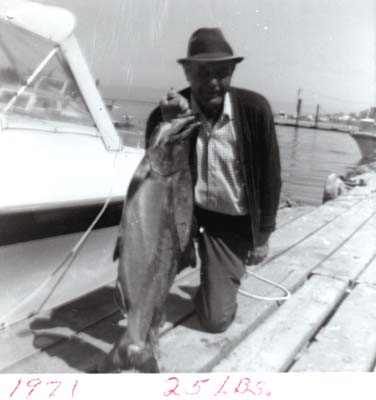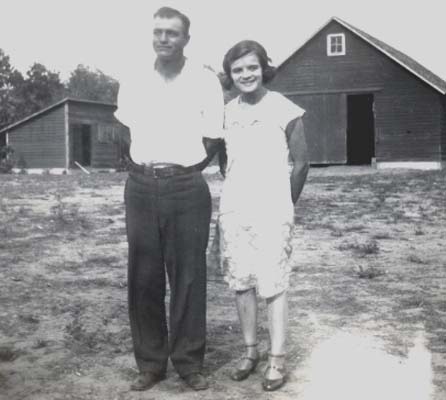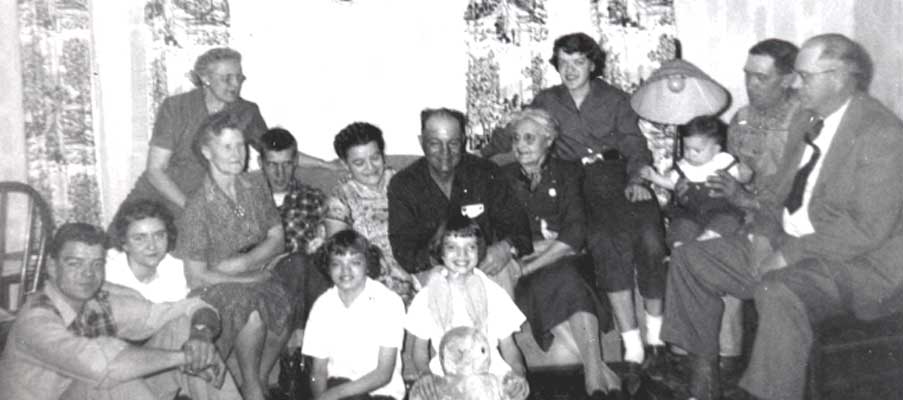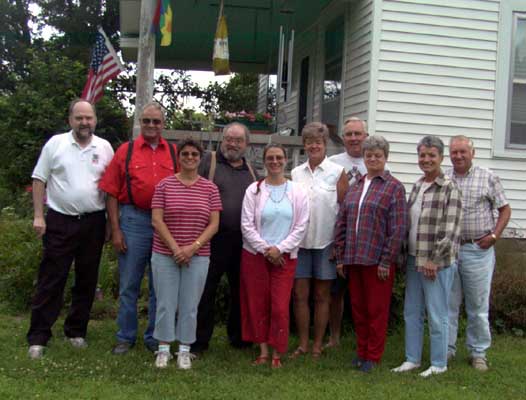I hope that this web page can become a collection of information and a resource for family and friends. I plan to update, and/or, correct this page as new information is discovered.
Thanks for your help.
Eugene (Gene) D. Johnson (son of Ellsworth and Rowena Heffley, grandson of Iver and Anna Ryan and great grandson of Sevn and Sigri Berg - JOHNSON)3. Sven Johannesen (Johnson) (1837 – 1931)
446 Trinity Drive, Allen, TX 75002
469-675-1316
Last updated: August 4, 2004
In 1860 Sven married Jorand Olsdatter (1835 - c.a. 1865)
They had the following child:
3.1. Julia (1865 - ?) m. C.J. Anderson
In 1866 Sven Married Sigrid Berg (1844 – 1912)
Sven and Sigri emigrated to Stanton County in 1868
They had the following children:
3.2. John S. (1866 – 1921) m. Mary Halverson
3.3. Rose (1869 – 1945) m. John Stangland
3.4. Iver S. (1879 – 1951) m. Anna Ryan
3.5. Sarah (1881 – 1962) m. John Midtlien
3.6. Anna (1883 - 1955) m. Theodore Ringer
3.7. Ida (1885 – 1966). m. James Johnson
The pictures below are of the Sven Johnson family taken in 1912 to celebrate Sven's 75th. birthday.
In the first picture, l/r in the first row:
Julia, Sven, Sigri, Rose.
In the top row:
John S., Anna, Ida, Sarah, Iver S.
In the second picture, l/r in the first row:
Julia, Sven, Sigri, John S.
In the top row:
Ida, Anna, Iver S., Rose, Sarah.
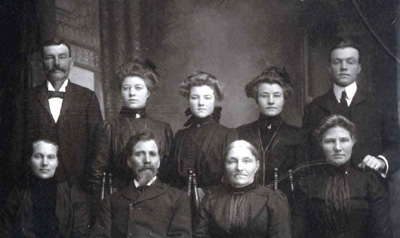
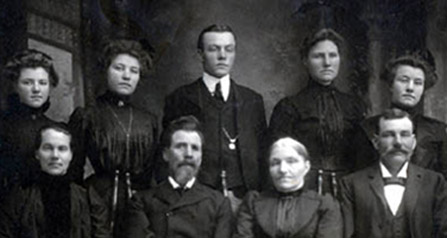
This page will discuss the family of John S. and Mary Halverson Johnson, Oldest son of Sven Johnson.
3.2.1. Helen Sylvia (1897) m. Oscar Field (no children)
3.2.2. Sherman M. (1899) m. Ursula Rosa Ziegler (1908)
--- 3.2.2.1. Lawrence Dean m. Helen Inez Lehman
--- 3.2.2.2. Sherman M. m. Faith Ann Glee Walter
--- 3.2.2.3. Mary Janice m. Marlow Henry Kohl
--- 3.2.2.4. Judith Ann m. George Ernest Godel
--- 3.2.2.5. Nancy Jo m. Robert David Scott
--- 3.2.2.6. Linda Sue m. Byron Keith Carmichael
--- 3.2.2.7. Andrew John
3.2.3. Leonard B. (1902) (not married)
John S. Johnson, Sven's son, married Mary Halverson. The following is from the Newman Grove Advertiser dated Friday 18 December, 1896 (page 5):
“John S. Johnson of Stanton and Miss Mary Halverson of Newman Grove were married Wednesday at the residence of John Simonson. Rev. Dale Performed the marriage ceremony”The June 6, 1900 census lists the following for Union Creek Precinct, Stanton County, Nebraska:
Johnson, John (33) Head, place of birth (pob) Norway,
Mary (27) Wife, pob Wisconsin,
Helen S. (2) dtr., pob Nebraska,
Sherman M. (1) son, pob Nebraska,
John died at the age of 54 years of Pneumonia. The following is from the Stanton Register dated 20 January, 1921 (page 5):
“FORMER STANTON CITIZEN IS DEADMary, his wife, was interviewed April 16, 1957, by the Norden Club. This transcript is available at the Nebraska State Historical Society. I copied it as follows:
The entire community was shocked last Friday to learn that John S. Johnson was at the point of death with pneumonia, and although many knew that he was quite ill, they had thought that his constitution would be able to withstand the attack. Mr. Johnson was taken sick about two weeks ago with chills and the disease was pronounced pneumonia. He apparently had no cold to begin with.
John S. Johnson was born August 7, 1866 in Fagernes, Valdres, Norway, and at the age of two years, came with his parents Sven and Sigri Johnson to America settling in Stanton County. He was baptized and confirmed in the Lutheran church and remained a faithful member.
On December 16, 1896, he was married to Miss Mary Halverson of Newman Grove, and they purchased a part of his father’s farm in Stanton County and built up a nice home here. To this union were born five children, two of whom preceded him in death. On account of the lack of good schools for their children they moved to Newman Grove in the spring of 1911.
In 1893 he spent the entire summer visiting the scenes of his birthplace in Norway and visiting his relatives there. He returned much rested and recuperated.
On December 28 he was taken seriously ill and in spite of the best of care and medical skill he passed to his eternal resting place on January 7, 1921 at the age of 54 years and 5 months. He leaves to morn his departure his wife, three children, Helen, Sherman, and Leonard; and aged father, Sven Johnson of Stanton; one brother Iver Johnson of Stanton; five sisters, Mrs. C.J. Anderson of Stanton, Mrs. J.A. Stangland of Albion, Miss Sarah Johnson of Stanton, Mrs. T.O. Ringer of Tilden and Mrs. James Johnson of Toronto, Canada…
Funeral services were held at the Shell Creek Lutheran church on Tuesday afternoon, conducted by the pastor, Rev. G.O. Mona… He was a man of few words but his kindly disposition made his friends numbered by those who knew him…”
“My maiden name was Mary Halverson. My name is Mrs. J.S. Johnson. I was born in Wisconsin close to Madison, Wisconsin. I was just two weeks old when the folks cane over here (Newman Grove). My father’s name was Halvor Halverson and my mothers name was Mary (Mary Nelson, daughter of Nils and Anne Nelson, who first married Halvor Halverson and then John Simonson). I was born in 1869. My parents were born in Norway. They were young when they came to the United States. When father died in an accident, mother was thirty years old. I had two sisters and two brothers born before me. I was two weeks old when I cam to Nebraska. We came to Nebraska in 1869. When we came here it was in 1872. They moved to Stanton, Nebraska first. My father was a farmer. He homesteaded down here about 2 miles east of here. We lived in a dugout for a little while. We didn’t live there more that a year and he made a house out of trees, a log cabin. There weren’t very many log cabins here. He made one for us and I think he helped to make another one for someone else. He was a tailor in Norway. My mother was a seamster in Norway.John S. and Mary Halverson Johnson's oldest daughter was Helen. The following is from the Newman Grove Register dated Wednesday, 11 October, 1922 (page 1):
He was going to Columbus with wheat and coming back he dropped one of the lines. We had one horse that was kinda kicky and of course as he bent down to get that line, he was killed. Mother was left with us children. There were some relatives and friends around here, but I can’t remember just who they were. Then several friends from Wisconsin came. Fields was one. We spoke Norwegian in our family. I didn’t know how to talk English until I started school. I went to school at Old Town. There was a school house just across the bridge. You see Old Town was the town that was across the bridge and then of course they built up here and then this got to be a new town and they called that Old Town. There was a store and a post office right in the store, and a blacksmith shop. Newman Grove was built later after we came here. We had to go clear to Columbus to have grain ground for flour, so they went to Columbus to trade. The post office was down to old town. Mrs. Hoffman took care of the post office, and she was postmistress there for a number of years.
Newman Grove got its name from a man who use to live here by the name of Newman, by the way I understand it. There were some Norwegians here when the town first started. My father was here. There were American people, I don’t know what nationality they were, but they spoke English.
The first school down at Old Town was all Norwegian. I don’t think that the teacher could speak Norwegian. Her name was Emma Jackson. Then there was a man teacher, his name was Mr. Square. He was my first teacher. In Old Town in a school house that is close to the bridge, there is a home there now. The school is up here now in New Town. I went to school all the time in Newman Grove. In later years there got to be ten years. At first if you got through the eighth grade, you were pretty smart.
We had a lot of good things to eat in the early days. They always butchered and then cured their own meat. Mother made flot bread, lefsa, soup and all kinds of bread, rye and white, and I cam remember of the folks having so much to eat all the time, we never starved. Norwegian food. I think some of these American ladies taught her to make pie. Now they make pie in Norway, there isn’t much difference between here and Norway that is the way I understand it. Mother made vegetable soup. She put rice, barley and many different things in it. At first it was kind of scarce for coffee, so they used to buy the green coffee and then roasted it and grind it in the coffee mill. That was for years that it lasted.
My family organized the first church here. There were two denominations. Now we have the Trinity and the Hauge. Then there was the Trinity church that I belong to now. I went to Sunday school in Hauge and was confirmed in Hauge Church, and married there. It was located right down not very far form where it is now. It is a little different. There is a residence there now and filling station. They moved a little west when they built that new church. Then they have added parts to it at different times. It is a very nice church. The services were in Norwegian. Then came Methodist and there is a Methodist church and we young folks went there sometimes, too. They stopped using Norwegian for quite a few years now.
It isn’t so many years that we had a minister that preached in Norwegian if anyone wanted it. I still talk Norwegian. There are a few that talk It around here and we talk it quite a bit. My husband and I both are Norwegian and we talk it sometimes. The kids never learned it. We never talked it enough. I was married in my home our in the country in 1896. Mr. Johnson was a farmer. His father (Sven Johnson) was a layman, farmer, mason, blacksmith, carpenter, he was everything, he could do anything. He came in the early days and learned everything he could. There were people around that would never go to town; they would just come there to get work done. He build houses for different ones. He was a swell tailor. He was awful handy. My husband never learned those things so much, he learned farming. I have three children living, and then we lost two boys. Leonard is in Spokane, Washington working on the railroad. He is a carpenter. Then Sherman, he is the oldest boy; he lives on a farm at Stanton, where my husband was raised, grandpa’s place. Helen lives here in town. I lived on the farm a good many years. We lived fifteen years down in Stanton, and then we moved up here on account of the kids to go to school. They had school down there at Stanton but we would have to drive a ways. We wanted to live where the kids could go to school. So, we then moved up to Old Town. They went to school and graduated all three of them.
The railroad came in not far from down here and the old location wasn’t so good, so they moved up here where they could have more room. There used to be a farm here. The clerks in town could speak Norwegian. The business was carried on in Norwegian. There was a Mr. Hovland, he was a Norwegian that came to the new country and started the store and run it for many years. He was a Norwegian and his wife. We use to hear the folks on the street speak Norwegian all the time. There are a few that sill do. But very few.
We always had luetfiske at supper Christmas. We don’t have that any more. We had a minister here that didn’t think we should. That was a way of making money. We had lefsa, flot bread, rummegraut. It is made out of cream. Just half sour cream and then a lot of them are crazy for it. They didn’t think there could be any dinner without that. We always had that. We used to cook up to 3 or 4 gallons of that cream. It was really good. We never had anything but the best cream. We had pie, cake, and everything you could think of. We have kringla prenels and fattigman. That was a funny way to give that name because it was made out of starch, but that is what they called it fattigman. It means a fat man.
We had a lot of singing. That was all that I liked to do was sing. I heard a tune and it didn’t take me long to learn, and my brother and sisters like to sing also. My mother was an awful good singer too. We used to sing Norwegian songs, but I don’t think I can remember any of them any more.
A custom of playing tricks called yulebok was you would dress awful funny and you would wear a mask. They wouldn’t know who your were. They would try to guess, but they weren’t supposed to tear your mask off or anything. They would dress up just awful. Some of them would wear a night dress over their clothes. They would go from house to house. They would just kinda of shake hands with them and talk to you. Sometimes they would know you. Oh, I use to do that. It was something like Halloween. They used to be tickled pink to have us come, especially the older people that couldn’t get out. If they had treats, they would treat you. They did that back in Norway. The custom came from there. In English that means Christmas goat.
There was a Norwegian doctor here by the name of Sanderson. He was good too. In all kinds of weather that he would be called to, he would maybe have a team of ponies, they had hard times.
I was scared half to death when the Indians came. They wanted me, because I was dark and mother was sure scared that they would take me. Then they would get out their knives and sharpen them and stand there. They would beg for something to eat and mother would give them bread and meat to get red of them. That is the way they went to every farm. They weren’t violent. We were scared half to death when we saw them coming, and we would run like everything. A man in Old Town had a pony just like that and sometimes when he would ride around the country we were scared half to death that he was an Indian, because he dressed sometimes like one. He didn’t wear shoes, just gunny sacks tied on as shoes. He was quite well to do, he helped the settlers out a lot. Of course, he always got it back. His name was Gunder Hamre.”
FIELD-JOHNSON
The wedding of Miss Helen Johnson and Mr. Oscar Field occurred last Thursday, October 5, ant the Trinity Lutheran Church; the ceremony being performed by the pastor, Rev. O.C. Hellekson…The bride was attended by Miss Florence Field, sister of the groom, and the groom was attended by Mr. S.M. Johnson, a brother of the bride…
The bride is a daughter of Mrs. John S. Johnson. She is a graduate in the class of 1917 of the Newman Grove high school and has been employed in the Farmers store for some time…
The bridegroom is the son of Mr. and Mrs. Sever S. Field and grew to manhood on a farm northwest of town. He is a graduate in the class of 1914 of the Newman Grove high school and after graduation attended a term at the Peru state normal school…
…the Field family being one of the old settlers of this part of the county. The groom’s family came here about ten years ago. The newly married people will make their home on the Field farm northwest of town…”
